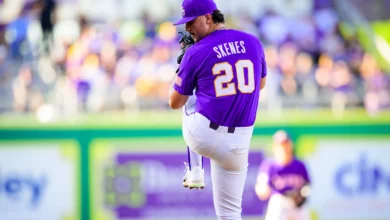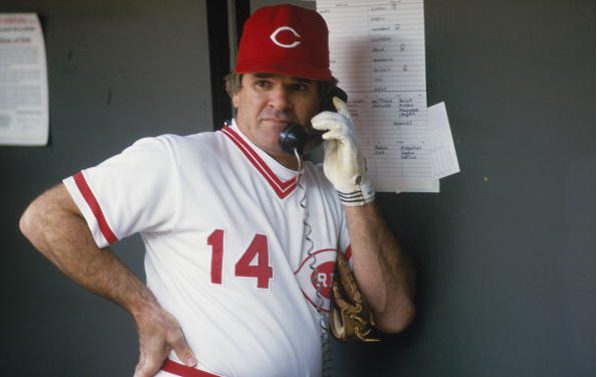
My all-time favorite All-Star Game was the 1971 game in Detroit at old Tiger Stadium. That was the game where six future Hall of Famers hit home runs. They were Johnny Bench, Henry Aaron and Roberto Clemente for the National League, and Reggie Jackson, Frank Robinson and Harmon Killebrew for the American League.
“Ain’t no way”
The starting pitchers were Vida Blue of the Athletics (17-3, 1.42 ERA at the time) and Dock Ellis of the Pirates (14-3, 2.11 ERA). Blue and Ellis were both black. Previously, no black pitcher had ever started the All-Star Game for either league. That’s right, folks, not even Bob Gibson, not even in 1968 when he finished 22-9 with a 1.12 ERA for the Cardinals and his own manager, Red Schoendienst, managed the NL team.
This time, Ellis had caused a stir and may well have forced his way into the starting berth. With Blue having already been designated the AL starter, Ellis was asked if he thought he would be chosen to start by NL manager Sparky Anderson. “Ain’t no way,” Ellis said, “they gonna start two brothers against each other in the All-Star Game.” Whether Anderson caved in to the pressure or was going to start Ellis anyway is lost to history.
In the bottom of the third with Luis Aparicio on first base, Jackson was summoned to pinch hit for Blue. Jackson crushed a home run for the ages, a towering shot to right field that would have left the old stadium had it not struck a transformer atop the roof. As memorable as Jackson’s homer was, Clemente’s was as funny. Clemente, who did not start the game, stood in the batter’s box in the top of the eighth to face the left-handed hometown hero Mickey Lolich. Lolich seemingly wanted no part of Clemente, who was visibly frustrated watching Lolich’s soft deliveries miss wide of the plate. Finally, with the count 3-1, Clemente flailed at a high pitch and sent it into the center field upper deck, stunning all who witnessed. The AL hung on to win that game, 6-4.
An “old man” rants
Having turned 65 this year and days from retiring from my day job (175 days as I write this, but who’s counting?), I figure I’m entitled to one “old man” rant. If that’s not your cup of tea, you can read something else. It’s a big internet.
So here goes. MLB’s All-Star Game ain’t what it used to be. Mind you, it’s still the best all-star game in sports. It’s still the one that most closely resembles the sport the way it’s supposed to be played. The NFL has finally given up on the Pro Bowl and replaced it with a series of skills competitions. Nobody plays defense in the NBA All-Star Game anymore. Who even understands the NHL All-Star Game format or can name five NHL players?
Even so, the MLB All-Star Game (and for that matter, the World Series) has lost a lot of its mystique and intrigue due to interleague play and the lack of players who spend their entire careers with one team. Fans used to anticipate the game, wondering how, say, Willie Mays might fare against Sam McDowell. Conversely, today if you’re wondering how Bryce Harper might do against Shohei Ohtani, you simply wait until their teams face each other, which they will next month. There’s always next year, too, when Ohtani may very well be pitching for the Dodgers.
Before interleague play and cable TV
I attended the All-Star Games in Pittsburgh, where I’ve lived my entire life, in 1974 and in Cleveland in 1981. I remember how excited I was in 1974 to see some of the AL stars in person. It was a time that preceded interleague play and cable television. The Pirates televised about 40 games per year, all on the road. I could see AL teams only whenever they were featured on the Saturday NBC Game of the Week. I rarely missed the opportunity.
It seemed in 1973, the Pittsburgh market got a lot of New York Yankees games with NBC’s “backup” broadcasting tandem, Jim Simpson and Maury Wills. From game to game, Simpson said the same things about the Yankees players. I still have them memorized. For example, there was Thurman Munson, who “runs well for a catcher.” There was Graig Nettles; if you wanted to know his worth, “don’t look at his average, look at his RBIs.” There was Bobby Murcer, who could have signed with the Dodgers for more money but chose the Yankees so he could play in the World Series. (Gee, didn’t that work out just swell for Murcer?) But I digress.
Baseball cards coming to life
My friend and I arrived at the 1974 game early to watch batting practice. I saw all of my favorite baseball cards coming to life. There were Aaron, Dick Allen, Lou Brock, Rod Carew, Al Kaline, Brooks Robinson, Jim Wynn, Carl Yastrzemski, et. al. right in front of me. The AL’s starting left fielder, Jeff Burroughs, seemed like an intruder. How dare he have the audacity to start that game while Kaline and Yaz sat, waiting their turn to get in!
With so much player movement has come a loss of league pride. That 1971 game had only five participants who had ever played for the rival league, all five being on the AL squad. Contrast that with the 2022 All-Star Game, which had 17 participants who had played in the other league. In my youth, players hated to lose to the other league in the All-Star Game. I won’t go as far as to say today’s players don’t care whether they lose the All-Star Game or not. But it doesn’t seem to bother them as much.
“I didn’t care about hurting myself”
For example, let’s look back at the 1970 game, played at Cincinnati. Tied 4-4 with two outs in the bottom of the 12th, the NL’s Pete Rose singled off Clyde Wright. The next batter, Billy Grabarkewitz, a forgotten man whenever this game is recalled, singled to move Rose to second. Jim Hickman followed with a single to center field, from where Amos Otis unleashed a strong throw to home. The ball arrived at home at the same time as Rose. With catcher Ray Fosse blocking the plate, Rose lowered his shoulder and knocked Fosse into the next week, sending the catcher sprawling with a shoulder injury, his glove and the ball flying in different directions, as Rose scored.
The play was controversial then and remains so. After the game, an angry Wright asked, “Why the hell did he have to do what he did?” Rose defended himself, saying, “That’s the only way I know how to play. I play to win . . . Don’t tell me it’s an exhibition or spring training. Don’t tell me to take it easy between the white lines . . . Besides, nobody told me they changed it to girls’ softball between third and home . . . The only thing I could do was run him over. I didn’t care about hurting myself if we could win.”
I’m no fan of Rose. To those upset that he’s banned from baseball, I say his problems were self-inflicted. But I agree with him here. A ticket to the All-Star Game is an expensive proposition. Paying fans want to see a real game.
“Joe and I did our best”
Contrast that to the 1993 game, with John Kruk at bat. Randy Johnson sailed the first pitch over Kruk’s head. Kruk wanted no part of the rest of that at-bat, standing as far from home as he could without leaving the box, laughingly waving at three pitches so he could return to the dugout in one piece. Then there was the 1997 game, when Johnson similarly greeted Larry Walker, who then turned around and batted right-handed for the only time in his life, helmet on backward.
Speaking of not giving the fans a real game, new heights of ridiculousness were reached in the 2002 game. After 11 innings with the two leagues tied, 7-7, managers Joe Torre and Bob Brenly sheepishly approached Commissioner Bud Selig and told him they’d run out of pitchers and had to end the game. The two teams had used a total of 19 pitchers between them. In the 1971 game, the two teams had used eight pitchers. Extra innings wouldn’t have been a problem then.
“It’s highly improper to try to place the blame on somebody,” said Brenly. “It happened because Joe and I did our best to get players into the game.” What was it, a Little League game? Selig apologized to the fans for not producing a winner, then praised the managers for not wanting to get any pitchers injured after the last pitchers used had pitched a whole two innings each. Somebody like Gibson would have pitched in that game until his arm fell off.
Hard to beat the world
I did not attend the All-Star Game when it came to Pittsburgh in 1994 and 2006. I had already seen two, and the prospect of spending a fortune to watch a made-for-TV game that was sure to drag on late into the night held no attraction for me.
In 2006, I got to attend the Futures Game thanks to the kindness of some friends who gave me enough tickets for my entire family. It was a nice time. It was my first chance to see Troy Tulowitzki, Joey Votto and Neil Walker, all of whom I would become a big fan, and Ryan Braun, who I would come to despise. I was glad in 2019 when they changed the game so that it now pits NL vs. AL (although that game ended in a tie, too). The United States vs. the World format was hard to follow and made no sense. Besides, it’s impossible to beat the whole world.





